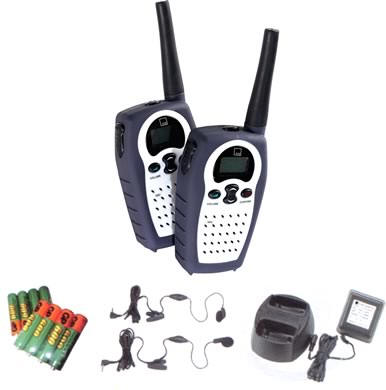CB Packet Radios made cheap with $50 DSE PRS walkie-talkies.
This project started with me buying a pair of reduced to clear DSE walkie-talkies. They came with some rechargeable batteries and a recharger. Below is a picture of what was in the box.

Specs of walkie-talkies:
- 2 x 40Ch UHF CB radios
- 500mW (0.5W) transmit power
- 8 x rechargeable batteries
- 2 x earphone microphones
- AC Adaptor
- Twin desktop charger
- Backlit LCD display
- Up to 3km outdoor line of sight operation range
- Key lock or unlock
- Low battery indicator
- Auto channel scan
- No user licensed required
- 4 x rechargeable batteries (included)
Opening up the walkie-talkies I saw that they had a little transceiver module in
them. A bit of experimentation I found that they only gave an IF output from the
receiver, a bit of a bother. The main problems I had though was I had no idea
how to control the frequency, and no idea what the many wires to the transceiver
module did. With a bit of luck and some computer software that allowed me to
monitor what the wires did (Universal Programmer Analyser), I managed to piece
together what purpose the wires had. looking through pages of ones and zeros I
managed to piece together also how the micro processor was controlling the
frequency.
After making numerous testes I designed the board and put the whole thing together. I make this sound a very easy thing to do, but it was extremely time consuming. below is a picture of of the finished product.
The DSE transceiver module is the little thing in the top left hand corner that is colored green. I used a bulk switching regulator to perform the voltage regulation, I think they are very nifty things, and it means the whole thing runs incredibly cool no matter what voltage you put into it. I designed it on a double-sided PCB trying to keep as much of the top side un-etched. on the bottom side there is IF FM demodulator with squelch, an RS232 interface, and a PIC chip controller. the PLL in the transceiver module makes it not possible to actually do FSK on the carrier frequency particularly well (as the PLL just corrects what it sees as frequency drift). what I did instead was decide to use AFSK, this means I plug it into the sound card on my computer, and let the computer do the encoding and decoding. Given another chance I would investigate more about FSK of the carrier frequency as this would increase throughput for the modem. Here is a picture of the board from below.
after all this effort I had to turn around and build yet another one, as having only one of them is comparable to having only one shoe, not much use. here they are together.
finally I could test them. I used a program called MixW to control them. Right off I worked out that the squelch circuitry that I had done was not adequate, it could not detect the carrier fast enough and the delay while my hardware detected it was too long. I turned it off and used MixW to do the dirty work.
Turnaround: On MixW I set the TX delay time to be 50ms and the RX delay time to be 50ms. this was about as small as I could see these values, as for why it needs a 50ms RX delay time I think this is due to the fact that the sound card and the serial port have a slight delay in them. what I mean by this is the soundcard is lagged a few milliseconds behind the serial port.
Throughput: Testing various throughputs I found I could get up to 9600 baud.
Packet Collision: A problem has been packet collision, especially when sending stuff by TCP/IP. I think if the modems were hardware based then this problem would be less, as there would be less lag between transmitting and detecting a carrier.
Distance: One of the fun things to test. 500mW is enough to get a little range at this frequency, although I feel that DSE is estimating the power of these things. it's not as line of sight as 2.5GHz WiFi. Firstly I ran a cable to the roof and placed the little UHF aerial on the TV mast. then I went to another house a bit over a kilometer from here, put the little aerial on top of a very long piece of wood. between the two houses there is a small hill and many trees and houses, but still I was able to connect to the other computer and transfer files. I was very pleased.
Conclusion: This was an interesting project to build.
Not exactly WiFi but the distance is a lot better. At a price of $100 for two of
these things makes it an affordable project. I'm sure with some time and effort
it would be possible to increase throughput (with FSK or maybe QAM) and decrease
turnaround time and packet collision. The techniques I did to figure out how the
transceiver module worked should also work for other walkie-talkies. This being
the case it should be possible for other people to build things similar to this.
If you decide to build something like this drop me an e-mail.
hardware
Software
Jonti
June 2006